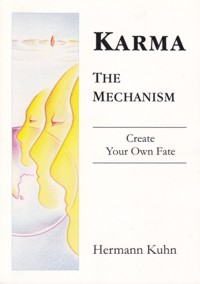
Kasayodayat tivra parinamash charitramohasya (14)
Intense negative emotions - rage (anger), arrogance (pride), the intention to deceive others and greed - prevent us to pursue activities that further inner growth. (14)
As long as we allow rage (anger), arrogance (pride), the intention to deceive others and addiction (greed) to control the direction in which our life moves, we attract two types of karma:
- karma that clouds our orientation of what is right or wrong and
- karma that prevents us to pursue activities we recognize as effective.
Effective action is all action that supports inner growth. The opposite of effective action deepens our immersion in the chain of incarnations. We experience karma that prevents effective action as
- an inability to identify in the hustle-bustle of daily life the lines of action that lead towards the ultimate freedom
- an only vague perception which activity will produce ultimate freedom
- an inability to perform or complete actions we recognize as effective and
- the illusion that certain actions would be necessary, harmless or even supportive for our growth.
We attract this type of karma when we enjoy or stimulate rage (anger), arrogance (pride), deception, or addiction (greed) in us and in others, or when we feel satisfaction and joy when others are overwhelmed by these negative emotions.
The power with which we endow these four negative emotions and the ensuing actions determines to a great degree what stages of development we can access. The intensity of negative emotions attracts four types of karma:
- The most intense form overshadows our consciousness so totally that we lose control over our actions while under the spell of these powerful energies. This intensity attaches us to error and erroneous intuition and blocks our orientation towards growth. The karmas we attract intensify our immersion in the first stage of development (mithyaktva) - the state of illusion, error and misconception of the mechanisms of this world. Since this is the only stage where karmas of this intensity can manifest, we cause an endless repetition of incarnations on this level if we don't check them.
- The second intensity does not overshadow us any more. Yet though its power is less intense, it still is strong enough to render us incapable of correcting our action while under its influence, or acting in a more positive way. These karmas keep us in the fourth stage of development (avirata-samyaktva). They fully block our recognition of the Five Freedoms. Though in this stage we possess clear and flawless intuitive insight into the real mechanisms of this world, we are unable to transfer this insight sufficiently into action to progress further. If we don't put energy into changing our attitudes, our stay in the fourth stage may last infinitely long.
- The third, moderate intensity allows only partial realization of the Five Freedoms. It prevents our entry into the sixth stage of development (pramatta virata).
- The fourth, mildest intensity blocks the perfect realization of the Five Freedoms. Though only weak tendencies towards the four negative emotions remains, this nevertheless prevents us from reaching the tenth stage of development (suksma samparaya).
The 14 stages of development and the Five Freedoms are described in the 'Application' part of the book in more detail.
When our emotions engage intensely in objects or events, this always signals that we want to experience the entire scope of insight these factors can offer us. And this always includes 'the other side of the coin' as well. When we e.g. direct violent emotion towards someone, we program this very moment that we also want to experience how the 'receiving' end of our emotions feels like. Once respective conducive conditions arise in our life, this karma is triggered, - usually at a time when we are as vulnerable as the person towards whom we directed our original negative emotions. This makes us experience how 'someone else' focuses his violent emotions on us and thus gives us the opportunity to go through the full scope of the event.
Unfortunately it often takes long time till - in the normal course of events - the respective conducive conditions arise. We thus may not clearly recall that we ourselves caused an experience of this kind. If we then react again with negative feelings, we catch ourselves in an endless circle of - actively and passively - manifesting the same intense emotions. If we want to break this vicious circle, it helps to become aware of this mechanism and then to consciously forego emotions like triumph or revenge, disdain or timidity, insatiability or loss at the very moment they arise.
The following examples demonstrate this karmic effect:
- Feeling fear, causing fear or enjoying the fear of others attracts karma that causes fear within us.
- Laughing at the misfortune of others, participating in cruel sports or cruel entertainment, playing practical jokes, teasing others, ridiculing the path to ultimate freedom etc. attracts karma that makes us victim of these types of activities.
- Desire for strange sense-enjoyments, shunning self-control etc. hardens our emotional (karmic) attachment to these types of activities. This attachment will remain active until the corresponding karma is dissolved, even if we do not enjoy the respective sense-pleasures any more.
- Feeling bored or discontented, intensifying and prolonging the discontent of others, intentionally ruining the happiness of others, associating with evil company etc. attracts karma that causes boredom and discontent within us.
- Aversion against positive behavior, spreading mistakes of others etc. attracts karma that causes disgust and repulsion. When this karma activates, it causes feelings of disgust even for those beings, things and actions we want to see in a positive light.
The next seven sutras list activities and attitudes that determine place and duration of our future incarnations.
 Hermann Kuhn
Hermann Kuhn
